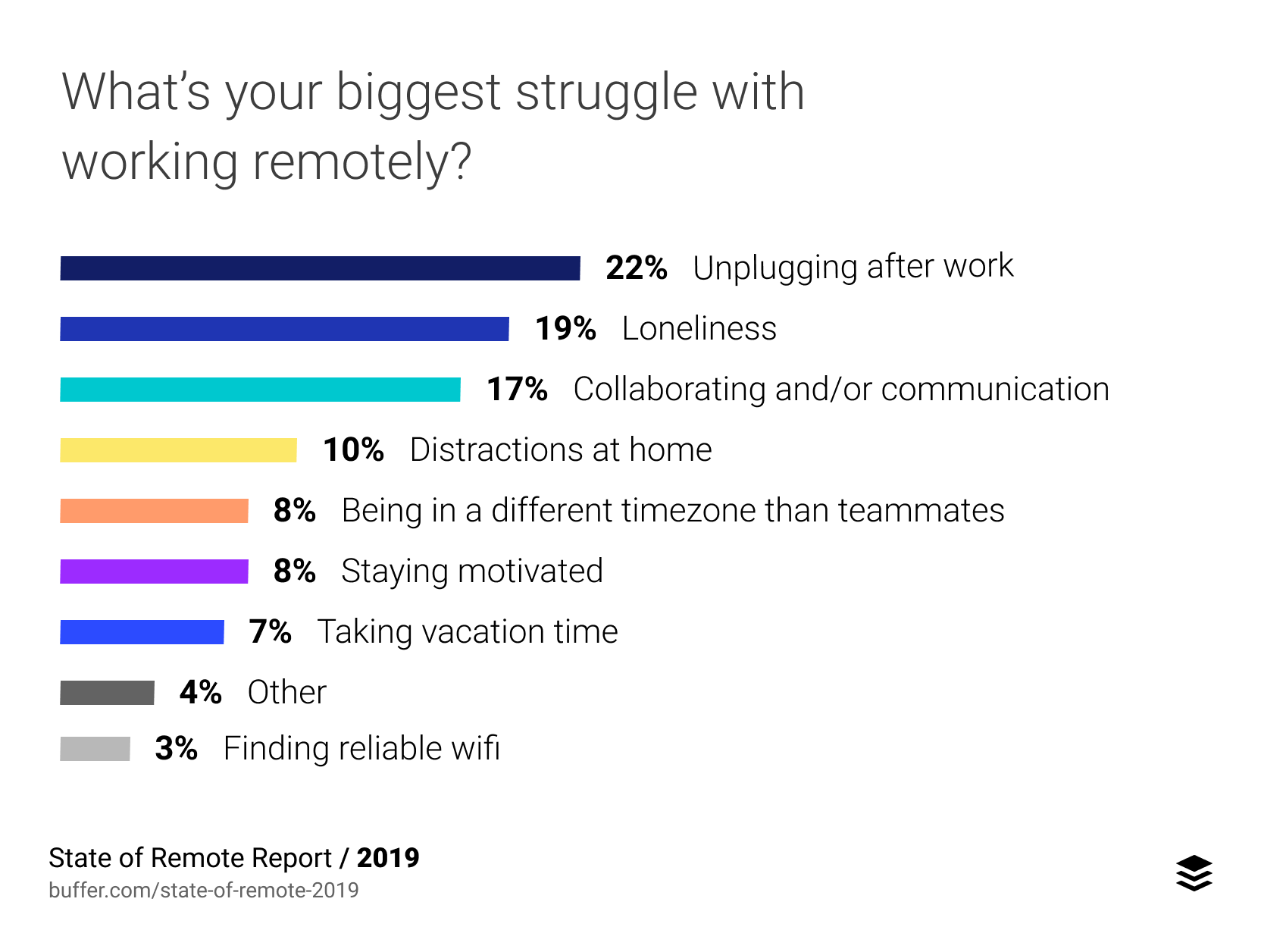What are the differences between working from home versus working in an office? Let’s compare them side-by-side to help you understand the unique advantages and disadvantages of each. Working From Home and Working in an Office.
Pesquisas da Owl Labs sugerem que aproximadamente metade dos funcionários normalmente trabalha em casa pelo menos uma vez por semana e um terço trabalha em trabalhos remotos em período integral.
Muitas organizações mudaram suas ferramentas e sistemas para equipes remotas pela primeira vez devido à pandemia de COVID-19. Para empregados e empregadores, este é um grande ajuste.
Pendulares
The average American worker spends at least 27 minutes on their daily commute to work, and it is getting worse. More than 14 million people spend an hour or more traveling to work,” according to NPR.
That’s a lot of time you can save by becoming a telecommuter! Telecommuting is another way to say working remotely or from home by making full use of the internet, email, and telefone.
No entanto, algumas pessoas gostam de acordar cedo, se arrumar e ter a separação entre casa e escritório. É por isso que muitas pessoas que trabalham remotamente ainda optam por ir a uma cafeteria ou a um espaço de coworking.
The bottom line is people hate commuting. Work-life balance continues to surge on the importance meter for modern-day employees. Companies that don’t recognize this are missing a huge opportunity to adopt trabalhar em casa estratégias que beneficiam sua força de trabalho.
A poll posted by CEO of Product Hunt, Ryan Hoover, suggests that most people would take a pay cut if it gave them the ability to work remotely. Perks like infinite vacation time, free food, and 401k weren’t as important when compared to the benefits of working remotely.
Digamos que você & #39; está procurando um novo emprego. O que é mais importante para você? 🤔
- Ryan Hoover (@rrhoover) 14 de setembro de 2018
Comunicação
De acordo com a pesquisa do nosso Relatório do Estado da Comunicação Empresarial 2020, a comunicação face a face é o método de comunicação preferido pelos funcionários.
Not counting video conferencing, face-to-face communication is something you really only get in an office space. It’s not only beneficial when planning for business, but it strengthens relationships and rapport with other employees. There’s something about relationship-building that happens when you sit next to someone or bump into each other at the coffee machine.
Communication still happens when you’re working remotely — it’s just different. Face-to-face communication turns into video calls. Short conversations turn into Slack messages. Emails … well, those stay emails. Nobody escapes those!
One compelling advantage of working from home is the ability to work anywhere. You don’t even need a laptop. With a full-featured aplicativo de telefone comercial, os funcionários podem fazer e receber chamadas, participar de teleconferências, enviar mensagens para colegas e permanecer on-line usando seu iPhone ou Android.
To improve communication for remote employees, we’ve seen many organizations require video conferencing over traditional phone calls when communicating with coworkers. Teams should have conference calls to align themselves with business goals. For fun, employees can even host online game nights to get to know each other outside of office life.
Algumas equipes até contam com as mídias sociais para comunicação. Por exemplo, Close.com diz que eles usar o Snapchat internamente for team building. It’s a cool and clever way to use social media to stay connected while working remotely.
Flexibilidade
When working from an office, it’s likely you have a set schedule. Your alarm goes off at the same time every day, you grab your morning coffee at 7:05 am, and you’re at your desk by 9 am ready to work.
When it comes to working from home, it’s a little different. You now have the flexibility to wake up when you choose and tailor your day to your needs. If your company is new to remote work, chances are they still want all employees working the traditional work hours of 9-to-5. With remote work, you can now wake up (a little) later, pick a time for lunch, and close your laptop when you want — for some, that’s 4 pm, others it could be 7 pm.
As more companies adopt a remote-first policy, working hours will shift to fit the employee’s schedule. This shift means more flexibility on when you start and end your day and where you work from. You should be able to work from anywhere that has a solid internet connection!

Many employees struggle to disconnect when working from home. Up to a third of employees say they struggle to balance work and home life when working remotely. It’s easy to shut down your computer when you see fellow office workers start to pack up for the night, but when you’re at home, those cues don’t exist.
The option to freelance and take on side projects is another massive benefit that comes with working from home. The time you waste on commuting could be put toward taking on side projects or freelancing. It’s far more lucrative than sitting through traffic jams!
Ambiente de escritório vs. Ambiente Doméstico
Você trabalha em um cubículo? Um plano de escritório aberto?
When working at the office, you don’t have a choice in your work environment or office setting. You might have a noisy coworker, or sit under the air conditioner, which could impact your productivity.
Trabalhar em casa permite que todos configurem seu home office ou estação de trabalho ideal.
Você pode escolher uma mesa de pé sobre uma sentada e selecionar sua escolha de móveis de escritório. Trabalhar em casa permite que você entenda seu ambiente de trabalho ideal, seja ele qual for.
Custos financeiros
The differences from working from home versus working at an office can be seen when it comes to finances — and we’re not talking about how much money you earn.
When working at an office, you pay for the costs of commuting, such as public transit, gas, or maintenance expenses. If you’re driving, you might also have to pay for parking. You likely also pick up a coffee or buy lunch during the day. All of these expenses add up.
When you work from home, there are tons of financial perks. You don’t have to worry about sitting in traffic, commuting expenses, and you won’t be tempted to go out after work and spend money on happy hours and eating out.
Working from home has its own costs. In addition to broadband internet costs, employees need to think about their energy costs like electricity. They may also carry “startup” costs for tecnologia de teletrabalho normalmente onerados pelos empregadores. As despesas típicas de trabalho em casa incluem mesas, cadeiras, roteadores de rede e monitores.
Embora você economize de algumas maneiras, existem outros tipos de custos a serem considerados.
Produtividade
Um estudo realizado pela UC Irvine descobriu que um trabalhador de escritório típico é interrompido every 11 minutes. If that wasn’t bad enough, it takes 25 minutes to get back on task. Yikes.
That’s a big hit to employee productivity. The nature of working remotely doesn’t make it inviting to chat with coworkers. Needless to say, productivity can get a huge uptick with remote workers. For example, call center employees that work from home were able to boost their productivity by 13%, according to a Stanford study. Consistent research has shown that remote workers log longer hours than their office-bound counterparts.
Studies show that it’s clear there is increased productivity in working at home versus working in an office. However, there can be a learning curve on how to increase your productivity and reduce distrações em casa.
Gestão
Many organizations have had to switch to remote work for the very first time. Managers are likely concerned because they’ve never had to gerenciar uma força de trabalho remota.
Ao trabalhar em um escritório, os gerentes têm uma visão clara do que os membros da equipe estão trabalhando. Eles podem subir e fazer perguntas, fazer check-ins diários e fazer reuniões de quadro branco para garantir que tudo esteja no caminho certo.
That’s not the case when it comes to working remotely.
É por isso que ter as ferramentas certas é fundamental para o sucesso do trabalho remoto. Aproveitamos uma combinação de grande liderança e ferramentas poderosas como a Asana para realizar grandes projetos.
Como gerente, você pode ter o desejo de microgerenciar os funcionários à medida que eles se tornam remotos. Em vez disso, sugerimos confiar nas pessoas até que provem o contrário. Funcionários quer to do well; it’s your job to help them get there.
Sempre haverá diferenças em trabalhar em casa vs. Trabalho remoto
Some call these differences advantages versus disadvantages — we call them opportunities. The team at Nextiva works remotely, and we’ve realized even more notable productivity gains from our sistema de telefone na nuvem to accelerate the shift from the office to work from home.
À medida que muitas empresas dão o salto, elas logo descobrirão que uma força de trabalho remota posso ser um movimento inteligente e estratégico. Para obter todos os benefícios, os empregadores (e os funcionários) precisam ser intencionais com seus comunicação Empresarial.



